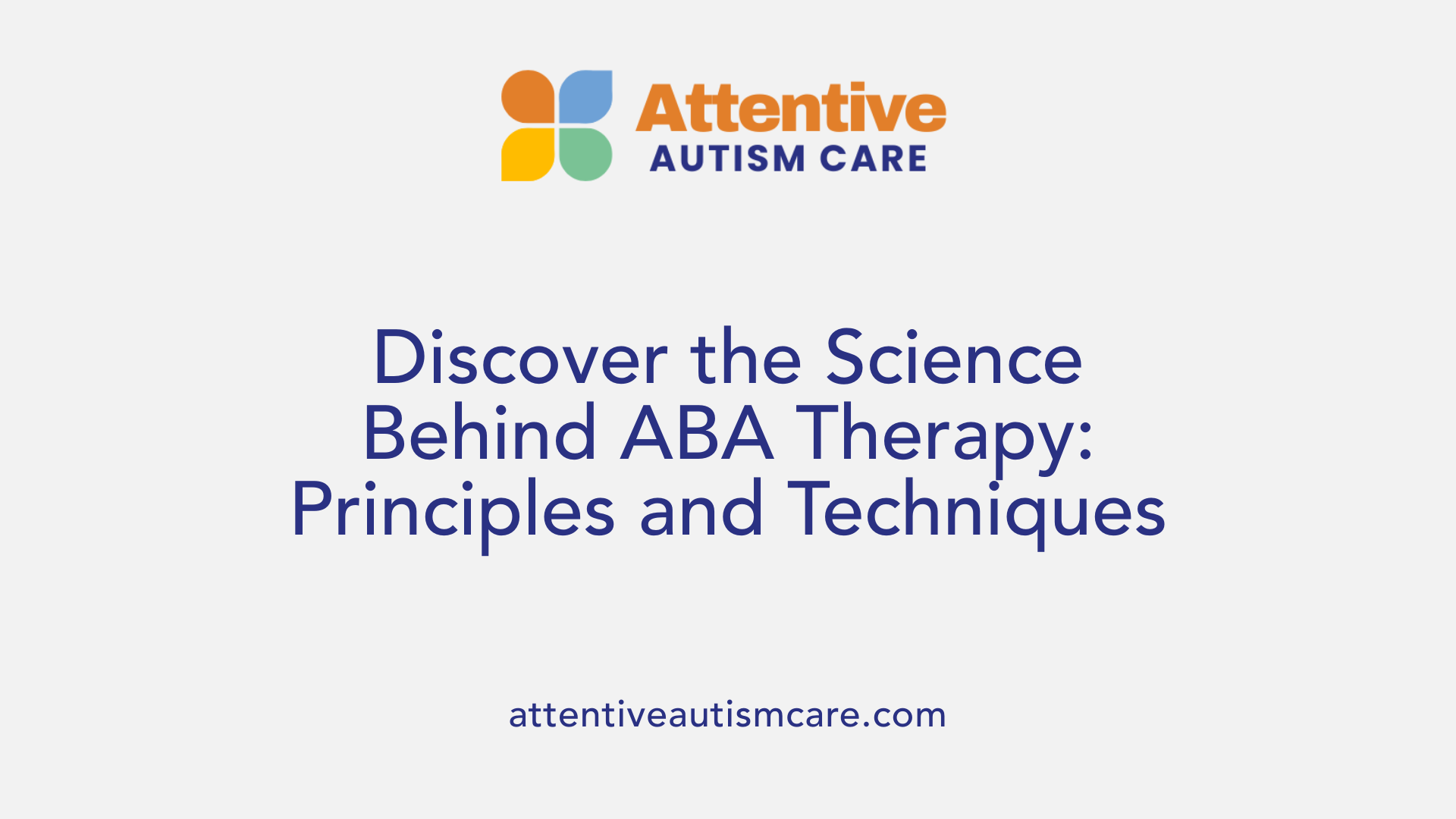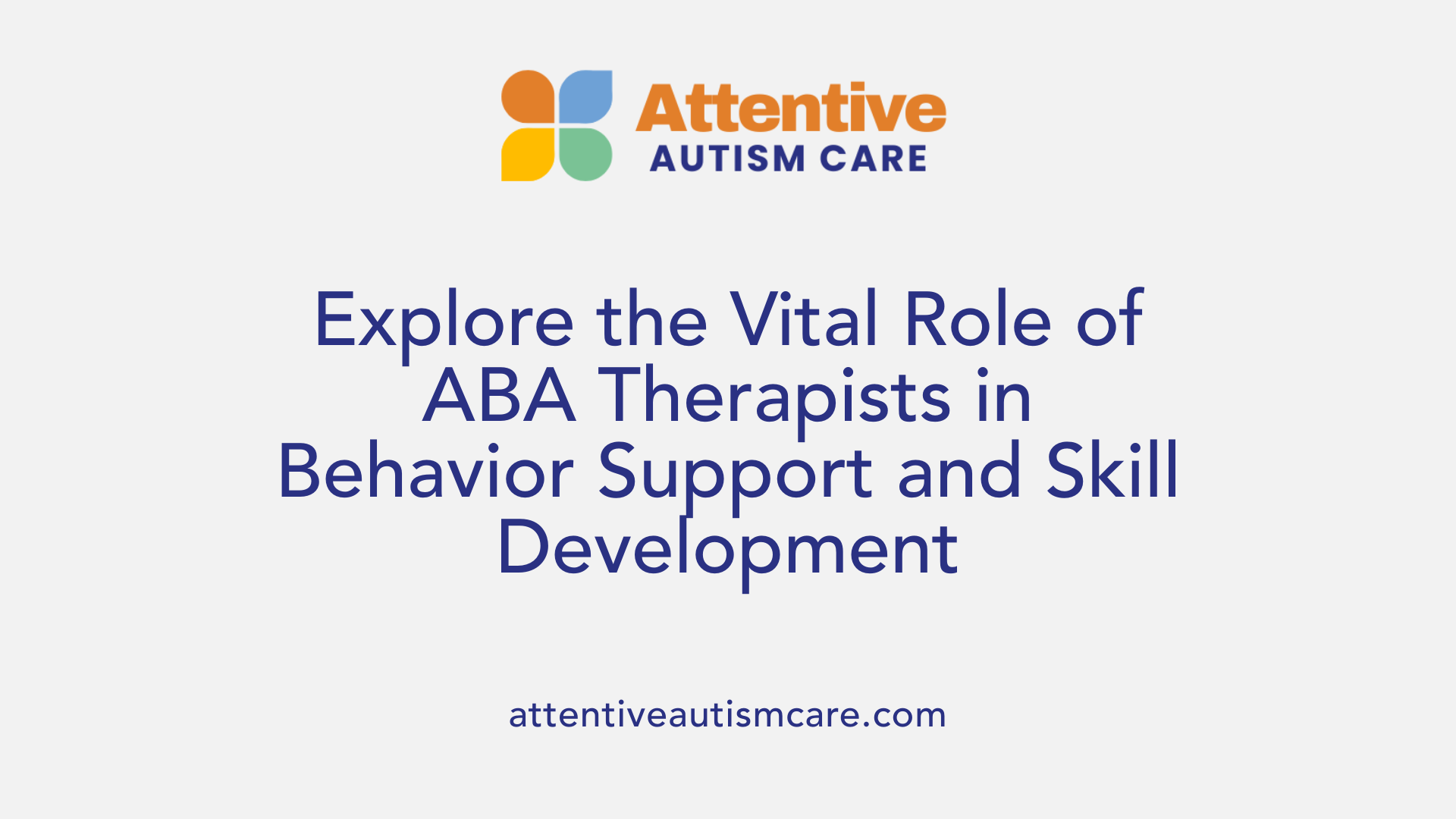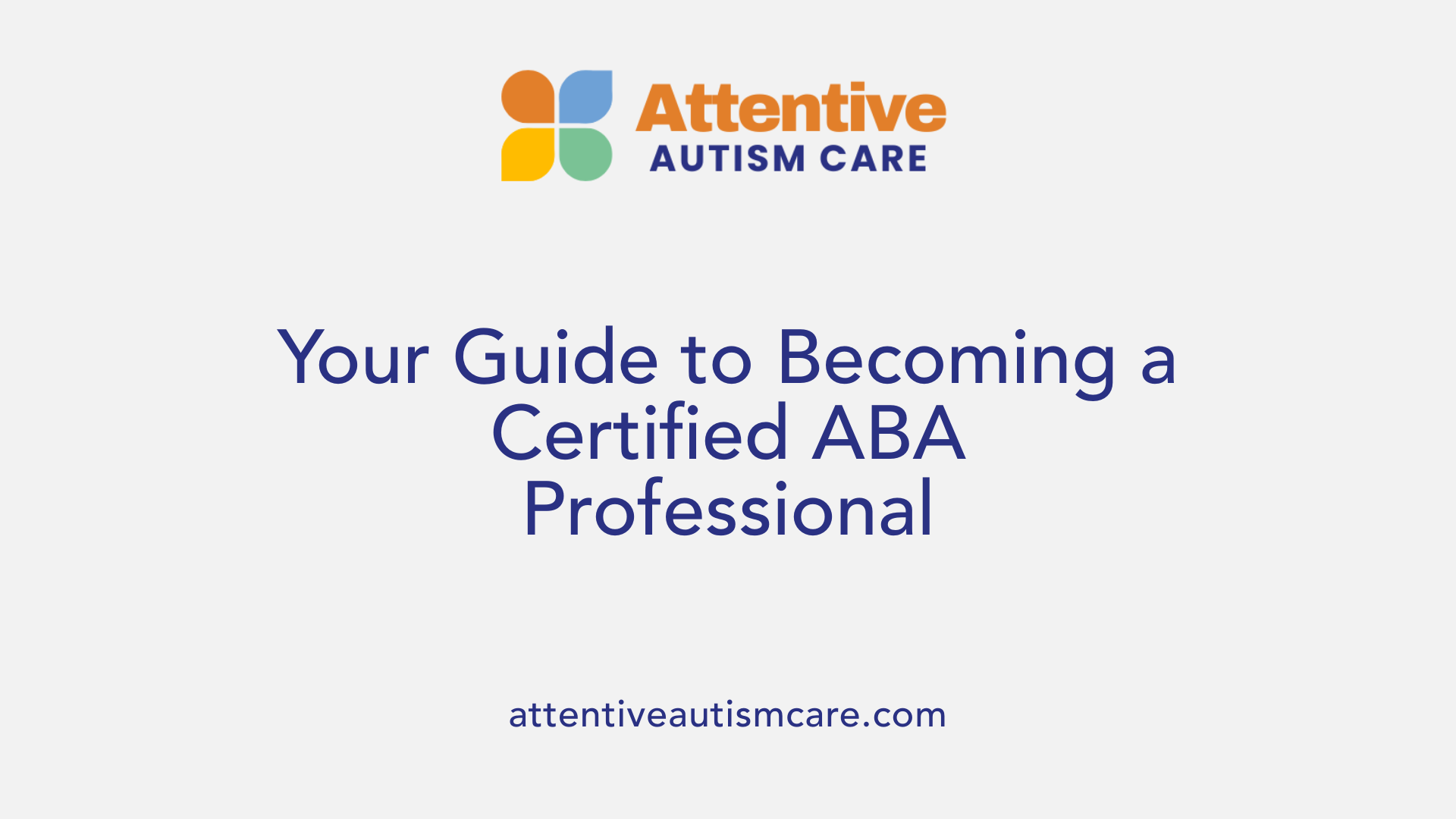What Is An ABA Therapist?
Understanding the Role of ABA Therapists in Behavior Change

What Is An ABA Therapist? An In-Depth Look
An ABA (Applied Behavior Analysis) therapist plays a vital role in delivering a scientifically validated approach to behavior modification and skill development, primarily for individuals with autism spectrum disorder (ASD) and other behavioral or developmental challenges. This article explores the scope of ABA therapy, the responsibilities and skills of an ABA therapist, and the broader context within which they operate, including the origins, techniques, and benefits of this evidence-based practice.
What Is ABA Therapy and How Does It Work?

What is ABA therapy and how does it work?
Applied Behavior Analysis (ABA) therapy is a scientifically supported approach used to improve social, communication, and daily living skills. It is rooted in the principles of learning and behavior, particularly operant and respondent conditioning. ABA helps individuals develop new skills and modify existing behaviors by focusing on observable actions.
The core of ABA involves analyzing behaviors using the ABC model — which stands for Antecedent, Behavior, and Consequence. Antecedents are what happen before a behavior occurs; the behavior is the specific action itself; and the consequence is what happens after the behavior, influencing the likelihood of it happening again.
By understanding these elements, therapists can identify environmental factors that trigger certain behaviors. They then use targeted strategies to promote positive behaviors and reduce problematic ones. Techniques such as positive reinforcement, prompting, modeling, and chaining are common tools within ABA.
Positive reinforcement involves rewarding desired behaviors to encourage their recurrence. Prompting and fading help guide individuals toward correct responses, gradually reducing assistance over time. Chaining breaks complex skills into smaller steps, teaching them sequentially.
Data collection is essential in ABA. Therapists systematically track progress and response to interventions, ensuring programs are tailored to each person’s unique needs. This ongoing data analysis allows for adjusting goals as individuals improve or encounter challenges.
The effectiveness of ABA is well-established through extensive research. It has demonstrated success in helping children with autism spectrum disorder (ASD) gain language, social skills, and independence. Many organizations, including the American Psychological Association, recognize ABA as a best practice treatment.
Goals of ABA focus on fostering independence and meaningful skill development. Whether it involves learning to communicate effectively, engaging socially, or managing daily routines, ABA aims to help individuals participate fully in society.
In summary, ABA therapy is a flexible, evidence-based method that employs a structured, data-driven process to bring about positive behavioral change. It emphasizes understanding individual behaviors in relation to their environment and applying scientifically supported techniques to improve quality of life.
The Role and Responsibilities of an ABA Therapist

What is the role of an ABA therapist?
An ABA therapist is a trained professional dedicated to helping individuals, especially children with autism or other developmental disabilities, improve various skills and behaviors. Their primary task is to implement personalized behavior support plans based on principles of Applied Behavior Analysis (ABA). These plans aim to increase helpful behaviors such as communication, social interaction, and daily living skills, while reducing harmful or learning-impeding behaviors.
ABA therapists work directly with clients across multiple environments — including homes, schools, clinics, and community settings — to carry out interventions and ensure consistency. They assess behaviors through functional assessments, which explore the relationships between behaviors and environmental factors. This information guides the development of effective, tailored strategies.
One of their main responsibilities is to teach new skills through techniques such as discrete trial training and reinforcement. They utilize strategies like positive reinforcement — rewarding desirable behaviors to encourage repetition — and prompting strategies to help clients perform new tasks.
Monitoring progress is an ongoing part of their role. ABA therapists collect data during sessions to measure responses and behavior changes. Based on this data, they adjust intervention strategies and set new goals, fostering continuous improvement.
Collaboration is essential in their work. They team up with families, teachers, and other professionals to incorporate behavioral strategies into the client’s daily routines. This often involves training caregivers and staff to implement ABA techniques effectively, ensuring that progress is maintained outside therapy sessions.
In addition, ABA therapists focus on reducing problematic behaviors, such as aggression or self-injury. They replace these with functional, adaptive behaviors that support independence and better functioning.
Overall, their work revolves around assessment, skill acquisition, behavior modification, and education. Their ultimate goal is to enable individuals to participate more fully in social, academic, and everyday activities, fostering a more independent and fulfilling life.
Techniques and Methods Used by ABA Therapists

What techniques are used in ABA therapy?
Applied Behavior Analysis (ABA) employs a variety of techniques aimed at changing behavior and teaching new skills. These techniques are evidence-based and tailored to meet individual needs.
One fundamental approach is positive reinforcement, where desirable behaviors are rewarded to encourage their repetition. This could involve giving praise, tokens, or access to preferred activities immediately after the targeted behavior occurs.
Antecedent interventions involve modifying or controlling what happens before a behavior occurs to prevent problematic behaviors and promote positive ones. For example, altering the environment or providing cues can help guide desired responses.
Behavioral chaining and task analysis break down complex tasks into small, manageable steps. Chaining then connects these steps in order, helping individuals learn sequences—like brushing teeth or putting on clothes—more effectively.
Modeling and simulation employ demonstration or video modeling of desired behaviors. Children and clients observe these behaviors and imitate them, which is especially useful for teaching communication and social skills.
A core assessment tool used by ABA practitioners is functional behavior assessment (FBA). This process helps identify the purpose or function behind specific behaviors by analyzing antecedents and consequences. Understanding the motivation behind behaviors enables therapists to develop targeted interventions.
Repetition, prompting, and fading techniques are essential for skill acquisition. Prompts—like cues or assistance—initially guide behavior, and gradually reducing these prompts (fading) encourages independence. Repetition reinforces learning, helping skills become automatic.
Data collection and analysis are central to ABA therapy. Therapists meticulously record behaviors and progress, which informs ongoing adjustments to interventions. It guarantees that techniques remain effective and are personalized to the individual.
Below is a summary table of these techniques:
| Technique | Description | Examples |
|---|---|---|
| Positive Reinforcement | Reward desired behaviors to strengthen them | Verbal praise, tokens, access to preferred activities |
| Antecedent Interventions | Modify environmental triggers to influence behavior | Visual cues, environmental adjustments |
| Behavioral Chaining & Task Analysis | Break complex skills into small steps, connect them | Step-by-step task breakdowns like brushing teeth |
| Modeling & Simulation | Demonstrate desired behaviors for imitation | Video modeling, role-playing |
| Functional Behavior Assessment (FBA) | Analyze behavior function to inform treatment | Observation, interviews, data analysis |
| Repetition, Prompting, Fading | Guide and gradually encourage independence in skills | Hand-over-hand assistance, gradually reducing support |
| Data Collection & Analysis | Measure progress and guide treatment adjustments | Behavior logs, progress charts |
These methods form the foundation of effective ABA therapy, providing structured and adaptable strategies to support learning and behavioral change.
Educational and Certification Pathways for ABA Therapists

How can one become an ABA therapist?
Starting a career as an ABA therapist involves a structured educational and professional pathway. Typically, the journey begins with earning a bachelor’s degree in psychology, education, sociology, or a related field. This foundational step provides the basic understanding of human behavior and developmental principles.
Once the undergraduate degree is obtained, aspiring ABA therapists often pursue graduate education, such as a Master's in Applied Behavior Analysis or related disciplines. Programs like the MS in Applied Behavior Analysis at Drexel University or specialized courses at other institutions are designed to meet the requirements for certification and provide in-depth training.
Certification plays a crucial role in professional advancement. The most common credential for direct service providers is the Registered Behavior Technician (RBT), which requires completing a 40-hour training program, passing a competency assessment, and successfully passing the certification exam overseen by the Behavior Analyst Certification Board (BACB).
For those aiming at higher-level roles, such as a Behavior Analyst, obtaining the BCBA (Board Certified Behavior Analyst) certification is necessary. This process involves completing graduate coursework approved by the BACB, accumulating 1,500 to 2,000 hours of supervised fieldwork, and passing the BCBA exam.
Supervised clinical experience is vital regardless of certification. It ensures that practitioners develop practical skills in functional behavior assessment, data collection, and intervention strategies.
Beyond initial certification, maintaining a license or credential involves completing continuing education units (CEUs) regularly, usually every two years, and renewing certification through the BACB.
Educational institutions such as Post University offer dedicated programs focusing on ABA coursework, including bachelor’s and master’s degrees aligned with certification requirements. Additionally, many universities incorporate ABA training into their special education or psychology curricula to prepare students effectively.
Overall, the pathway to becoming an ABA therapist combines academic achievement, practical experience, credentialing, and ongoing professional development—ensuring practitioners stay current and effective in their roles.
| Educational Step | Typical Requirements | Additional Notes |
|---|---|---|
| Bachelor’s Degree | Degree in psychology, education, or related field | Provides foundational knowledge |
| Graduate Education | Master’s in ABA or related field | Meets coursework requirements for BCBA |
| RBT Certification | Complete 40-hour training, pass competency exam | Entry-level para-professional role |
| BCBA Certification | Graduate coursework, supervised hours, certification exam | For advanced clinical roles |
| Supervised Fieldwork | 1500-2000 hours | Essential for BCBA certification |
| Continuing Education | CEUs every 2 years | Maintains certification |
This pathway offers a clear route for individuals passionate about making a difference through ABA, ensuring they gain the knowledge, skills, and credentials needed for a successful career.
Applications and Benefits of ABA Therapy
What are the benefits of ABA therapy?
ABA therapy provides a variety of positive outcomes for individuals with autism and other developmental challenges. One of its primary advantages is the significant improvement in communication abilities, enabling children to better express their needs and understand others. Social skills also tend to improve, helping children participate more effectively in interactions with peers and adults.
In addition to enhancing social and communication skills, ABA therapy often boosts independence by teaching daily living skills such as personal hygiene, self-care, and emotional regulation. These improvements help children become more self-sufficient and confident in different environments.
Early, intensive ABA interventions have been associated with remarkable developmental outcomes. When started before age 4 and delivered with high frequency—about 20-40 hours weekly—children often experience accelerated progress. Studies show that such early intervention can lead to better language development, increased IQ, and more adaptive behaviors, which may even result in some children losing their autism diagnosis.
ABA's scope extends beyond autism alone. It is effective for a range of conditions including ADHD, OCD, traumatic brain injury, and severe emotional or behavioral issues. Its adaptable and data-driven approach allows therapists to tailor programs to meet individual needs, emphasizing positive reinforcement and skill-building.
Overall, ABA is a scientifically supported treatment that helps individuals develop crucial life skills, reduce problematic behaviors, and achieve greater social participation. When implemented by trained professionals, it offers a structured, engaging, and personalized pathway toward improved quality of life for many individuals.
Criticisms and Ethical Considerations of ABA
What are common criticisms or limitations of ABA therapy?
Applied Behavior Analysis (ABA) has been highly effective for many, but it also faces significant criticism within the neurodiversity community and among some practitioners. One of the earliest concerns stems from the historical use of aversive procedures. In its origins during the 1960s, some ABA programs employed techniques like electric shocks and punishment to modify behavior. Although these methods are now largely abandoned and replaced with positive reinforcement strategies, residual concerns about inhumane treatments persist.
Critics argue that traditional ABA can be rigid, formulaic, and focused excessively on behavior change without respecting the individual's natural ways of expressing themselves. For example, behaviors like stimming—repetitive motions or sounds—are sometimes suppressed under strict ABA protocols, despite their importance for sensory regulation and emotional self-soothing.
Additionally, there are debates about the societal goals of ABA. Some autistic advocates believe that the therapy emphasizes conformity, aiming to make autistic children appear more neurotypical, which can lead to emotional harm or trauma. Reports of children experiencing distress, anxiety, or even PTSD after intense or poorly implemented ABA sessions have raised ethical questions about the adequacy of consent, individual autonomy, and the potential for coercive practices.
The focus on behavior modification also brings concerns about respect for neurodiversity. Critics argue that while ABA can help develop useful skills, it should not aim to eliminate genuine aspects of a person's identity. Instead, they call for approaches that support acceptance and accommodate differences rather than attempting to 'normalise' behavior.
Furthermore, access to quality ABA therapy is uneven, often limited by socioeconomic and geographical factors. Cost barriers, lack of qualified practitioners in some regions, and caregiver skepticism or cultural beliefs can restrict who benefits from early intervention.
In conclusion, while ABA has proven benefits, ongoing debates and criticisms highlight the need for ethical, flexible, and person-centered approaches that prioritize individual well-being, respect neurodiversity, and ensure equitable access to services.
The Future of ABA and Opportunities for Careers
Growing demand for ABA services due to increased autism diagnosis rates
The number of children diagnosed with autism spectrum disorder (ASD) continues to rise, which has led to a higher demand for applied behavior analysis (ABA) services. The CDC estimates that approximately 1 in 36 children in the U.S. is on the autism spectrum. This increase means more families are seeking early intervention and ongoing support, creating a strong job market for qualified ABA professionals.
Diverse career options including clinical, educational, and research roles
Careers in ABA are varied and include roles such as Board Certified Behavior Analysts (BCBAs), Assistant Behavior Analysts (BCaBAs), and Registered Behavior Technicians (RBTs). Professionals work in clinical settings, schools, homes, and community organizations. Some may focus on designing and overseeing treatment plans, while others implement daily interventions and data collection.
Specializations like organizational behavior management, sports psychology, and gerontology
Beyond autism treatment, ABA professionals can explore specialties such as organizational behavior management, which applies principles to improve workplace productivity and culture. Other areas include sports psychology, helping athletes enhance performance, and behavioral gerontology, focusing on elderly populations. These specializations expand career paths and allow practitioners to apply ABA principles in diverse contexts.
Opportunities in telehealth and remote service delivery
The rise of telehealth has made ABA services more accessible, especially for individuals in remote or underserved areas. Telehealth allows practitioners to conduct sessions via video conferencing, providing flexibility and broadening the reach of ABA therapy. This growth opens new job opportunities for professionals trained in remote service delivery and digital therapy tools.
The importance of ongoing education, certification, and ethical practice
Professional development is crucial in ABA. Maintaining certification as a BCBA, BCaBA, or RBT involves ongoing coursework, supervision, and adherence to ethical standards set by organizations like the Behavior Analyst Certification Board (BACB). Ethical practice ensures high-quality, respectful, and effective interventions, protecting both clients and practitioners.
Post University and other institutions offering ABA-related programs
Educational institutions such as Post University offer graduate programs like Master of Science in Applied Behavior Analysis, which meet coursework and training requirements for BCBA certification. These programs prepare students through comprehensive coursework, supervised practical experience, and preparation for certification exams. Many universities and colleges worldwide now include ABA as part of their special education, psychology, or behavior analysis curricula.
Career outlook for ABA therapists
Overall, the career outlook for ABA therapists is highly positive. The increasing demand for services driven by higher autism diagnosis rates ensures ongoing job stability and growth. The profession offers a variety of roles, specializations, and work environments, along with opportunities for remote practice. Continuous education, ethical standards, and certification are essential for career advancement and success in this expanding field.
| Aspect | Details | Additional Notes |
|---|---|---|
| Demand | Rising due to increased autism diagnoses | CDC estimates 1 in 36 children on the spectrum |
| Roles | BCBAs, BCaBAs, RBTs | Clinical, educational, research |
| Specializations | Organizational behavior, sports psychology, gerontology | Broadens career options |
| Telehealth | Growing for remote service | Increases accessibility |
| Education | Undergraduate + graduate programs | Certifications required for practice |
| Certification | BCBA, BCaBA, RBT | Ongoing coursework and supervision |
| Ethical Practice | Maintains quality and professionalism | Essential for credibility |
| Educational Institutions | Post University, ASU, others | Offer ABA-specific degrees and certificates |
| Career Outlook | Very positive | Stable growth and diverse opportunities |
Summing Up the Role of ABA Therapists
ABA therapists are crucial in applying scientifically validated methods to help individuals with behavioral and developmental challenges lead more independent and fulfilling lives. Their work, grounded in a rich history of research and ethical practice, involves assessing behaviors, designing tailored interventions, and working collaboratively with families and other professionals. As awareness of autism and related conditions expands, so does the need for qualified ABA practitioners across multiple settings. With robust educational pathways, certification requirements, and a focus on ongoing learning, ABA therapy offers a meaningful and impactful career aligned with advancing behavioral science and improving lives.
References
- Applied Behavior Analysis (ABA) | Autism Speaks
- Applied behavior analysis - Wikipedia
- How to Become an ABA Therapist - Drexel University
- Applied Behavior Analysis (ABA) - Cleveland Clinic
- The Controversy Around ABA - Child Mind Institute
- What ABA Therapists Do - LeafWing Center
- Applied Behavior Analysis: What Is It and How Does It Work? - WebMD




































































































